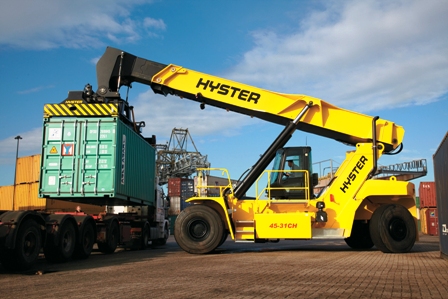
New emissions regulations known as Tier 4 interim / Stage IIIB, effective January 2011, apply to all new diesel powered off-highway equipment sold in the EU and North America. As these regulations affect materials handling equipment used in ports, terminals and heavy industry, Hyster recently announced that it will use EGR engine technology rather than SCR in its range of Big Trucks, to achieve compliance and to make it easy for users. Jan-Willem van den Brand, Hyster Big Trucks Global Product Strategy Manager explains the facts about EGR and SCR.
To minimise the NOx (Nitrogen Oxides) and PM (Particulate Matter) emissions from diesel engine exhausts to levels that comply with the new Tier 4 interim / Stage IIIB emissions legislation, equipment manufacturers have a choice of two types of engine technologies, SCR (Selective Catalytic Reduction) or EGR (Exhaust Gas Recirculation).
Before making any buying decisions, it is important that purchasers of equipment with engine power over 130 kW (174hp) should check which technology is used as it may affect the operation and infrastructure of a site.
What are SCR and EGR?
With an SCR solution the higher combustion temperature in the engine creates less PM but more NOx. To reduce the NOx, SCR technology uses a chemical fluid called Diesel Exhaust Fluid (DEF), or urea, and a catalytic converter to reprocess the exhaust gases and reduce the NOx emissions.
The intake of a urea resin (known as AdBlue in Europe) into the exhaust system permits the conversion of NOx into water vapour and nitrogen, which is harmless. AdBlue is added to a special tank attached to the fuel tank.
The second technology is EGR, a technique that is combined with a Diesel Particulate Filter or DPF. The EGR cools part of the exhaust gas before reintroducing it into the engine with the air intake. This allows a more controlled burn at lower combustion temperature and reduces NOx emissions levels. The lower combustion temperature creates more PM which are captured by the DPF.
How does the technology affect operators?
There are positives and negatives for both technologies, but with EGR the end user does not have to change the way it operates. Diesel fuel is added to the tank in exactly the same way and the engine does the rest with no additional equipment, additives or maintenance regimes. This is a "Just Diesel, Nothing Else" solution.
The alternative, SCR, requires an extra tank to contain the AdBlue, and drivers need to top up the tank adding extra time to a standard refuelling operation. There are also logistical problems as urea should not be stored close to the standard diesel refilling area and must be stored in temperatures above - 11°C, otherwise it hardens. The infrastructure for the supply of urea for industrial and construction industry is also sometimes not readily available.
While SCR has its disadvantages for the user, it has become the standard for many manufacturers of on-highway equipment and the supply for AdBlue has improved over the last few years. Looking to the future, SCR may also offer a potential solution to reach the next stage of Tier 4 / Stage IV compliance for off-highway equipment.
Intelligent Design for Hyster Big Trucks.
Following significant reviews of both technologies, Hyster ReachStackers, container handlers and forklift trucks with lift capacity over 16 tonnes will now be powered using Cummins engine technologies that incorporate EGR. With rapid engine response, thanks to the Cummins VGT and with various Hyster performance optimisation techniques, the new Hyster Big Trucks with EGR can deliver fuel savings in the region of 15%. The lower operating cost and no need to invest in a urea supply infrastructure, Hyster has again delivered dependable handling equipment with a low total cost of ownership.